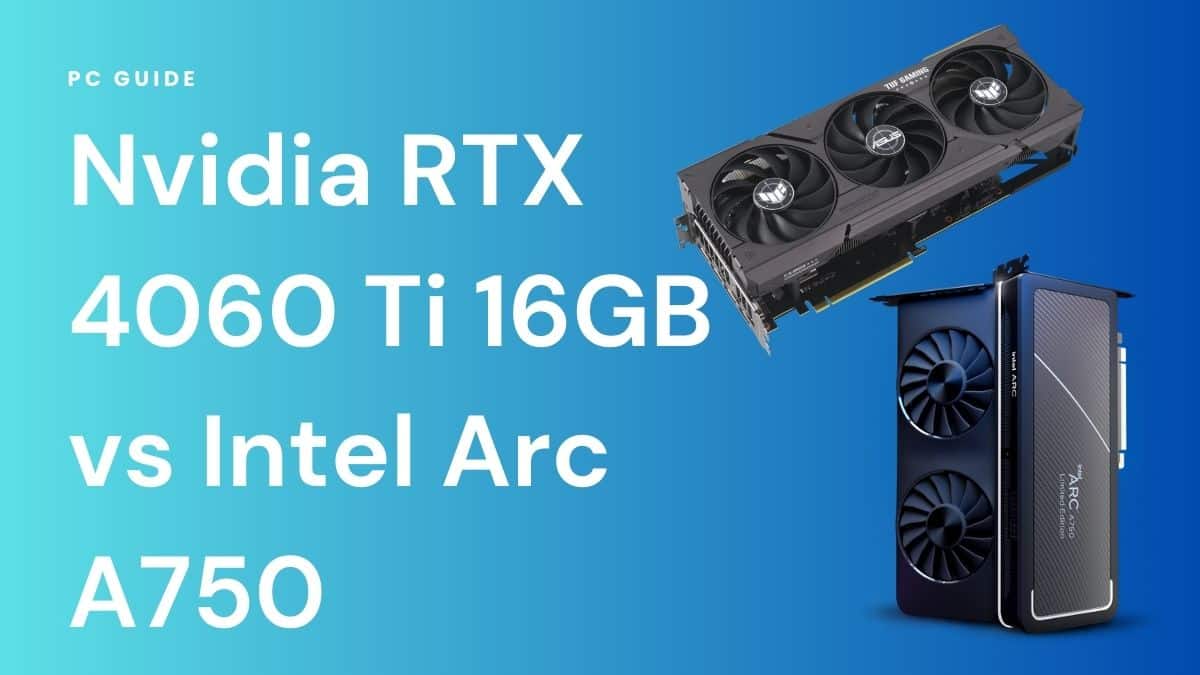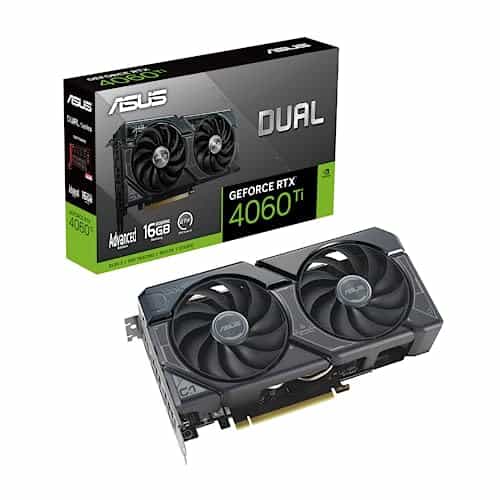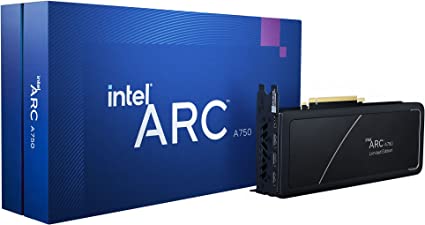Nvidia RTX 4060 Ti 16GB vs Intel Arc A750 – is Intel an option?

Table of Contents
In this comparative review, we delve into a head-to-head matchup between Nvidia’s RTX 4060 Ti 16GB and Intel’s Arc A750. Our goal in this article is to help you understand which GPU comes out on top. We will dissect their architecture, compare their core configurations, and explore their performances, all to provide a clear perspective on their gaming and professional workload capabilities. Welcome to the Nvidia RTX 4060 Ti 16GB vs Intel Arc A750 face-off.
Nvidia RTX 4060 Ti 16GB vs Intel Arc A750: Introduction
Both of these graphics cards have raised eyebrows and caused quite a buzz within the GPU community. Nvidia packs a punch with its middle ground contender, the RTX 4060 Ti 16GB, packing an impressive 4352 CUDA cores and a whopping 16GB of GDDR6 memory.
Prime Day is finally here! Find all the biggest tech and PC deals below.
- Sapphire 11348-03-20G Pulse AMD Radeon™ RX 9070 XT Was $779 Now $739
- AMD Ryzen 7 7800X3D 8-Core, 16-Thread Desktop Processor Was $449 Now $341
- ASUS RTX™ 5060 OC Edition Graphics Card Was $379 Now $339
- LG 77-Inch Class OLED evo AI 4K C5 Series Smart TV Was $3,696 Now $2,796
- Intel® Core™ i7-14700K New Gaming Desktop Was $320.99 Now $274
- Lexar 2TB NM1090 w/HeatSink SSD PCIe Gen5x4 NVMe M.2 Was $281.97 Now $214.98
- Apple Watch Series 10 GPS + Cellular 42mm case Smartwatch Was $499.99 Now $379.99
- ASUS ROG Strix G16 (2025) 16" FHD, RTX 5060 gaming laptop Was $1,499.99 Now $1,274.99
- Apple iPad mini (A17 Pro): Apple Intelligence Was $499.99 Now $379.99
*Prices and savings subject to change. Click through to get the current prices.
On the other hand, Intel has made an impactful entrance with its Arc A750, boasting a substantial 3584 cores and 8GB GDDR6 memory but with an intriguing higher memory bandwidth and lower price point.
Nvidia RTX 4060 Ti 16GB vs Intel Arc A750: Specs
The most striking difference between these two GPUs lies in their VRAM. The Nvidia GeForce RTX 4060 Ti 16GB comes with a beefy 16GB of GDDR6 memory. Intel’s Arc A750, on the other hand, is equipped with 8GB of GDDR6 VRAM.
When it comes to memory interface width and bandwidth, the Arc A750 takes the lead. Despite having half the VRAM of the RTX 4060 Ti 16GB, it boasts a broader memory interface width (256-bit compared to Nvidia’s 128-bit) and a significantly higher memory bandwidth (512.0 GB/s versus 288.0 GB/s).
| Specs | RTX 4060 Ti 16GB | Intel Arc A750 |
|---|---|---|
| Architecture | AD106 | DG2-512 |
| CUDA cores | 4352 | 3584 |
| VRAM | 16GB GDDR6 | 8 GB GDDR6 |
| Memory Interface Width | 128-bit | 256 bit |
| Memory bandwidth | 288.0 GB/s | 512.0 GB/s |
| Texture units | 136 | 224 |
| Base clock speed | 2310 MHz | 2050 MHz |
| Boost Clock speed | 2535 MHz | 2400 MHz |
| L2 Cache memory | 32 MB | 16 MB |
| Graphics Card Power (TDP) | 165W | 225W |
| MSRP | $499 | $289 |
Despite these noteworthy features of the Intel Arc A750, it’s worth pointing out that Intel is a newcomer in the GPU market. Their architecture is still in the early stages compared to Nvidia’s matured and well-tested designs. The Arc A750 houses fewer cores (3584) compared to RTX 4060 Ti’s 4352 CUDA cores, 34 RT cores, and 136 tensor cores.
Nvidia RTX 4060 Ti 16GB vs Intel Arc A750: Performance
Surprisingly, despite the difference in their specifications and technologies, the gap in performance between the Nvidia RTX 4060 Ti 16GB and the Intel Arc A750 is not as pronounced as one might expect. Both GPUs are some of the best graphics cards in the business.
The Nvidia RTX 4060 Ti 16GB, thanks to its more advanced architecture and technologies, manages to eke out a victory in the hardware benchmarks. The 3rd generation Ray Tracing, frame generation and DLSS technologies built into the RTX 4060 Ti give it a considerable edge, improving performance, especially in games and applications that utilize these features.
However, the superiority of the RTX 4060 Ti 16GB over its competitors is less dominant than one would assume. Although the GPU delivers excellent performance, it’s not a significant leap forward from its siblings in Nvidia’s line-up. This can be attributed to the shared architecture and similar technologies used across Nvidia’s product range. Any motherboard will require a PCI-Express 4.0 slot.
On the other hand, while Intel’s Arc A750 may not outperform the Nvidia RTX 4060 Ti 16GB in raw performance, it’s still a commendable achievement for the CPU giant. Intel has made considerable strides with its debut GPU and, despite trailing behind Nvidia and AMD, the Arc A750 shows that Intel has the potential to compete in the GPU market.
Nvidia RTX 4060 Ti 16GB vs Intel Arc A750: Price
The Intel Arc A750, priced significantly lower than the Nvidia RTX 4060 Ti 16GB even at launch price, is a clear winner in terms of affordability. Even though it falls slightly behind in performance, the cost-effectiveness of the A750 is undeniable. For budget-conscious gamers, the A750 provides a viable, value-for-money option that doesn’t skimp on performance.
Intel’s ability to provide a competitively priced GPU is a testament to its vast resources and commitment to expanding into new segments of the PC tech industry. While Nvidia’s RTX 4060 Ti 16GB is undoubtedly a more powerful GPU, its higher price point can be a deterrent for many potential buyers, especially those working with tight budgets.
Is Arc better than Nvidia?
Based on our comparison of the Nvidia RTX 4060 Ti 16GB and the Intel Arc A750, we can say that Nvidia’s GPU offers better performance due to its more advanced architecture and technologies like 3rd-gen Ray Tracing and DLSS. However, the performance gap between the two is not very wide.
Final thoughts
In a straight head-to-head comparison between the Nvidia RTX 4060 Ti 16GB and the Intel Arc A750, the winner isn’t as clear-cut as one might expect. Nvidia, with its established reputation and advanced GPU technology, delivers superior performance, but the Intel Arc A750 holds its own, providing a commendable level of performance at a much lower price point.
While the Nvidia RTX 4060 Ti 16GB offers an excellent balance of power and efficiency, it’s hard to overlook the value proposition of the Intel Arc A750. If you’re on a budget and seeking a GPU that can handle gaming and professional workloads adequately, the Intel Arc A750 is a very worthy consideration.



